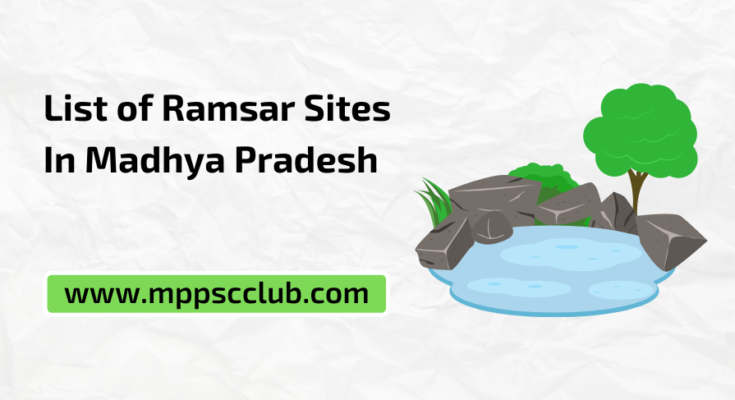Friends, Here we will check the List of Ramsar Sites in Madhya Pradesh.
Ramsar Convention
The Ramsar Convention is an international treaty aimed at the conservation and sustainable use of wetlands. It was signed in 1971 in the city of Ramsar, Iran.
India joined the Ramsar Convention in 1982 and has since designated 85 Ramsar sites covering an area of 1,358,068 hectares as of 2024.
World Wetland Day is celebrated on 02 February every year.
Ramsar Sites in Madhya Pradesh
As of August 2024, Madhya Pradesh has five designated Ramsar sites. These are wetlands of international importance recognized under the Ramsar Convention for their ecological significance:
1. Bhoj Wetland
- Bhopal
- 2002
- Area – 310 km²
- It consist of two lakes, Upper and Lower, and are vital for supporting a rich diversity of flora and fauna, including many migratory bird species.
2. Sirpur Wetland
- Indore
- 2022
- Area – 14.4 km²
3. Sakhya Sagar
- Shivpuri – Madhav National Pakr
- 2022
- Area – 21 km²
4. Yashwant Sagar
- Indore
- 2022
- Area – 8.22 km²
5. Tawa Reservoir
- Narmadapuram
- 2024
- Area – 200.5 km²
- It is constructed at the confluence of the Tawa and Denwa rivers.
- The reservoir is located inside the Satpura Tiger Reserve.
| Ramsar Site | Location | Designated Year | Area (in km²) |
|---|---|---|---|
| Bhoj Wetlands | Bhopal | 2002 | 310 |
| Sirpur Wetland | Indore | 2022 | 14.4 |
| Sakhya Sagar | Shivpuri (Madhav NP) | 2022 | 21 |
| Yashwant Sagar | Indore | 2022 | 8.22 |
| Tawa Reservoir | Narmadapuram | 2024 | 200.5 |
Ramsar Sites In India
You can check out the complete list of Ramsar Sites in India from below link –
[List of Ramsar Sites in India]
Significance of Wetlands
Ecological Significance
1. Biodiversity Hotspots : Wetlands are home to a wide variety of species, including endangered and migratory birds, fish, amphibians, reptiles, and plants.
2. Water Purification : Wetlands act as natural filters, removing pollutants, sediments, and excess nutrients from water, improving its quality.
3. Flood Control : Wetlands help absorb excess rainwater and reduce the intensity of floods by acting as natural buffers.
4. Climate Change Mitigation : Wetlands store significant amounts of carbon, helping to regulate the global climate and reduce greenhouse gases.
5. Groundwater Recharge : Wetlands help replenish groundwater supplies by allowing water to slowly infiltrate into aquifers.
Economic Importance
6. Livelihood Support : Wetlands provide resources such as fish, reeds, and other materials, supporting the livelihoods of local communities.
7. Agriculture : Wetlands contribute to agriculture by maintaining water tables and providing water for irrigation.
8. Tourism and Recreation : Wetlands attract ecotourism, such as bird watching, boating, and fishing, contributing to local economies.
9. Natural Resources : Many wetlands provide timber, peat, and other natural resources that are used for energy, construction, and industry.
Environmental Importance
10. Erosion Control : Wetlands stabilize shorelines and riverbanks, reducing erosion caused by waves and currents.
11. Storm Protection : Coastal wetlands, such as mangroves, provide protection against storm surges, hurricanes, and tsunamis.
12. Habitat Connectivity : Wetlands often serve as crucial links between terrestrial and aquatic ecosystems, ensuring the migration of species.
Cultural and Social Importance
13. Cultural Heritage : Many wetlands have cultural, spiritual, and historical significance for indigenous and local communities.
14. Educational and Scientific Value : Wetlands serve as natural laboratories for ecological research and environmental education.

